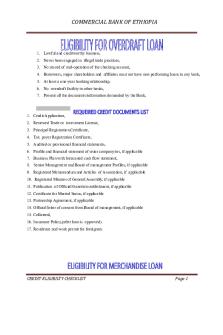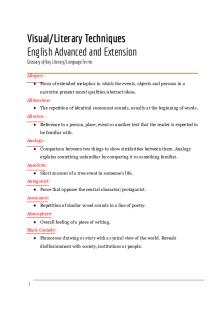List of Persuasive Techniques for English essays PDF

| Title | List of Persuasive Techniques for English essays |
|---|---|
| Course | English |
| Institution | Victorian Certificate of Education |
| Pages | 3 |
| File Size | 84 KB |
| File Type | |
| Total Downloads | 9 |
| Total Views | 131 |
Summary
A detailed list of persuasive techniques and their meanings as well as how they work and how they position the audience. Useful for language analysis essay....
Description
Ad Hominem. Ad hominem is a Latin word that means “against the man.” As the name suggests, it is a literary term that involves commenting on or against an opponent, to undermine them instead of their arguments. Alliteration. The repetition of words starting with the same to create emphasis. e.g. ”And I can tell you it is distressing beyond words to watch an animal suffer like that and not be able to alleviate its agony.” Anecdotes. Short, personal stories that help to illustrate a point. e.g. “For my three most recent books, on motherhood, cancer and nursing, I interviewed more than 300 people about the nuts and bolts of what our incredibly short time on this planet is really about – life, death, family and love. If there is one thing I can guarantee, it’s that there will never be a person who lies on their deathbed, shaking with rage, sobbing, ‘Dear God, I wish I’d spent more time watching MasterChef.'” Cliches. An overused expression. Although they should be avoided, cliches give writers an opportunity to express an idea to their readers quickly. Here are some examples of cliches: • Absence makes the heart grow fonder. • Alls well that ends well. • As light as a feather. • Time will tell. Colloquial language is language that is informal and conversational. A colloquialism is a word or expression that is commonplace within a specific language, geographic region, or historical era. Colloquialisms are useful in many ways as literary devices. They can provide personality and authenticity to characters and dialogue in a literary work. Colloquialisms can also indicate the setting of a literary work in the context of time and place by establishing a historical era or geographic area.
Exaggeration. Writers often exaggerate or overstate something to help persuade readers of their point of view. e.g. “Our experts will tell you a million reasons why it can’t or shouldn’t be done here. They have turned excuse-making into an art form.” Evidence. Writers will often use evidence – which might take the form of facts, figures, quotes or graphs – to help support their argument. e.g. “According to the Australian Bureau of Statistics, males are 400 per cent more likely to commit an offence intended to cause injury than are females.” Expert opinion. Sometimes writers will use the opinion of experts to give further weight to their argument. e.g. “A new research report by Victorian doctors illustrates why: because when kids are worried their parents will be told their private medical details, they simply don’t go to the doctor.” Inclusive language. Inclusive language – using the words ‘we’ or ‘us’ – is often used to get a reader onside. e.g. “We might not like it, but our kids’ right to confidential medical advice should take precedence over our right to know about it.” Imagery. Descriptive writing can be a powerful persuasive technique. Describing something vividly can persuade readers. Juxtaposition. Juxtaposition is a literary device that implies comparison or contrast. Writers create juxtaposition by placing two entities side by side to create dramatic or ironic contrast. This allows the reader to discern how the paired entities are similar or different. Metaphor. Metaphors, when one thing is described as another, help to persuade by describing. e.g. “I’ve been dying of it all week and can hardly type this column because of the Niagra of snot pouring down my face and the painful fires of a thousand suns burning in my joints and muscles, which being manly muscles are able to carry a much heavier load of pain than lady muscles.” Pun. A play on words often relying on homophones, homonyms or rhymes. e.g. “It’s been a trying year for rugby league, what with betting scandals, controversies over players’ alleged off-field behaviour and an unseemly on-field
brawl that marred the sport’s reputation on approach to the finals.” e.g. “Racism is no black and white issue”. Repetition. The repetition of words, phrases and ideas can be used to reinforce an argument and drive home the message to a reader. e.g “It has been well established here and overseas that if teenagers think they can see a doctor in confidence, they are more likely to do so, more likely to go back for repeat visits, and more likely to disclose sensitive information.” Rhetorical question. A question where the answer is obvious, can help lead readers to a particular conclusion. e.g. “It has been well established here and overseas that if teenagers think they can see a doctor in confidence, they are more likely to do so, more likely to go back for repeat visits, and more likely to disclose sensitive information. And isn’t this the outcome we want? “ Sarcasm. A mocking tone. e.g. “Not all of us can write Max Walker’s How to Hypnotise Chooks, you know – for many years the biggest-selling title in Australian literary history.” Simile. Similes, when one thing is compared to another, can help to persuade by describing. e.g. “…as dumb as a sack of hammers…”...
Similar Free PDFs

Techniques of English
- 7 Pages

Literary Techniques List
- 7 Pages

English Analysis Techniques
- 2 Pages

Product Check List English
- 32 Pages

Evaluative language for essays
- 1 Pages

Sample Essays for SOC101
- 20 Pages
Popular Institutions
- Tinajero National High School - Annex
- Politeknik Caltex Riau
- Yokohama City University
- SGT University
- University of Al-Qadisiyah
- Divine Word College of Vigan
- Techniek College Rotterdam
- Universidade de Santiago
- Universiti Teknologi MARA Cawangan Johor Kampus Pasir Gudang
- Poltekkes Kemenkes Yogyakarta
- Baguio City National High School
- Colegio san marcos
- preparatoria uno
- Centro de Bachillerato Tecnológico Industrial y de Servicios No. 107
- Dalian Maritime University
- Quang Trung Secondary School
- Colegio Tecnológico en Informática
- Corporación Regional de Educación Superior
- Grupo CEDVA
- Dar Al Uloom University
- Centro de Estudios Preuniversitarios de la Universidad Nacional de Ingeniería
- 上智大学
- Aakash International School, Nuna Majara
- San Felipe Neri Catholic School
- Kang Chiao International School - New Taipei City
- Misamis Occidental National High School
- Institución Educativa Escuela Normal Juan Ladrilleros
- Kolehiyo ng Pantukan
- Batanes State College
- Instituto Continental
- Sekolah Menengah Kejuruan Kesehatan Kaltara (Tarakan)
- Colegio de La Inmaculada Concepcion - Cebu









